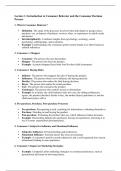Lecture 1: Introduction to Consumer Behavior and the Consumer Decision
Process
1. What is Consumer Behavior?
Definition: The study of the processes involved when individuals or groups select,
purchase, use, or dispose of products, services, ideas, or experiences to satisfy needs
and desires.
Interdisciplinarity: Combines insights from psychology, sociology, social
psychology, anthropology, and economics.
Example: Understanding why consumers prefer certain brands over others based on
cultural influences.
2. Consumer vs Shopper
Consumer: The person who uses the product.
Shopper: The person who buys the product.
Example: A parent (shopper) buys baby food for their child (consumer).
3. Consumers' Buying Roles
Initiator: The person who suggests the idea of buying the product.
Influencer: The person whose views influence the buying decision.
Decider: The person who makes the final buying decision.
Buyer: The person who makes the actual purchase.
User: The person who consumes the product.
Gatekeeper: The person who controls access to information.
Example: In a family, the child (initiator) asks for a toy, the sibling (influencer)
agrees, the parents (deciders) decide to buy, the mother (buyer) purchases it, and the
child (user) plays with it.
4. Pre-purchase, Purchase, Post-purchase Processes
Pre-purchase: Recognizing a need, searching for information, evaluating alternatives.
Purchase: Deciding on and buying the product.
Post-purchase: Evaluating the product after use, which influences future decisions.
Example: Researching laptops (pre-purchase), buying one (purchase), and using it to
see if it meets expectations (post-purchase).
5. Consumer’s Subjective Influence and Situational Influence
Subjective Influence: Personal feelings and preferences.
Situational Influence: External factors like store environment.
Example: A consumer's positive mood (subjective) and a well-organized store layout
(situational) leading to more purchases.
6. Consumer’s Impact on Marketing Strategies
Example: Companies tailor marketing strategies to consumer preferences, such as
personalized ads based on browsing history.
,7. Marketing Segmentations
Psychographic Segmentation: Grouping consumers based on lifestyle, values, and
personality.
Behavior Segmentation: Grouping based on consumer behavior such as purchasing
patterns and loyalty.
Demographic and Geographic Segmentation: Based on age, gender, income, and
location.
Example: Targeting fitness enthusiasts (psychographic) with gym memberships,
frequent buyers (behavior) with loyalty rewards, young adults (demographic) with
trendy fashion, and urban residents (geographic) with city-specific offers.
8. Selling Concept vs Marketing Concept
Selling Concept: Focus on selling products regardless of consumer needs.
Marketing Concept: Focus on understanding and meeting consumer needs.
Example: Pushing sales through aggressive advertising (selling concept) vs
conducting market research to develop products that meet consumer needs (marketing
concept).
9. Customer Value
Definition: The consumer’s assessment of the overall capacity of a product or service
to satisfy their needs and wants.
Example: Valuing a smartphone for its high functionality and sleek design.
10. Value Disciplines
Product Leadership: Offering leading-edge products.
Operational Excellence: Efficient delivery of products.
Customer Intimacy: Building close relationships with customers.
Example: Amazon’s efficient delivery system (operational excellence).
11. Purpose: Keep it Simple
Example: Apple’s focus on user-friendly product design.
12. Consumer Buying Decision Process/Dual Process Theory
The Buying Decision Process: Need recognition, information search, evaluation of
alternatives, purchase decision, post-purchase behavior.
Example: Buying a car involves recognizing the need for transportation, researching
models, comparing features, deciding on a purchase, and evaluating satisfaction post-
purchase.
13. First Moment of Truth, Second Moment of Truth, ZMOT
First Moment of Truth (FMOT): When a consumer first encounters a product.
Second Moment of Truth (SMOT): When a consumer uses the product.
Zero Moment of Truth (ZMOT): Research phase before encountering the product.
, Example: Reading reviews online (ZMOT), seeing the product in-store (FMOT), and
using the product at home (SMOT).
14. Need Recognition
Internal vs External Stimuli: Internal - Hunger; External - Advertisement.
Need vs Opportunity: Recognizing a need (hunger) vs seeing an opportunity (sale).
Example: Feeling hungry (internal) and seeing an ad for a restaurant (external).
15. Primary vs Secondary Demand
Primary Demand: Demand for a product category.
Secondary Demand: Demand for a specific brand.
Example: Demand for smartphones (primary) and demand for iPhones (secondary).
16. How Can We Find Out What People Want?
Self-interest, Marketing Myopia, Pyramid of Needs.
Example: Conducting surveys to understand consumer needs (self-interest) and
avoiding focusing solely on selling existing products (marketing myopia).
17. Information Search
Internal vs External Sources: Internal - Memory; External - Friends, media.
Example: Recalling past experiences (internal) vs reading product reviews (external).
18. Evaluation of Alternatives
Traditional View of Brand Sets: Considering a set of brands before making a
decision.
Example: Comparing different brands of laptops before buying one.
19. What is an Attitude?
Definition: A learned tendency to evaluate things in a certain way.
Example: A positive attitude towards eco-friendly products.
20. Multi-attribute Model (Fishbein)
Definition: Evaluating products based on multiple attributes.
Example: Rating a smartphone based on battery life, camera quality, and price.
21. Non-compensatory Models of Choice
Conjunctive Heuristics: Setting minimum standards for attributes.
Disjunctive Heuristics: Acceptable criteria based on key attributes.
Lexicographic Heuristics: Ranking attributes by importance.
Elimination-by-aspects Heuristics: Eliminating options that don’t meet criteria.
Example: Choosing a car based on the most important attribute like safety
(lexicographic).




